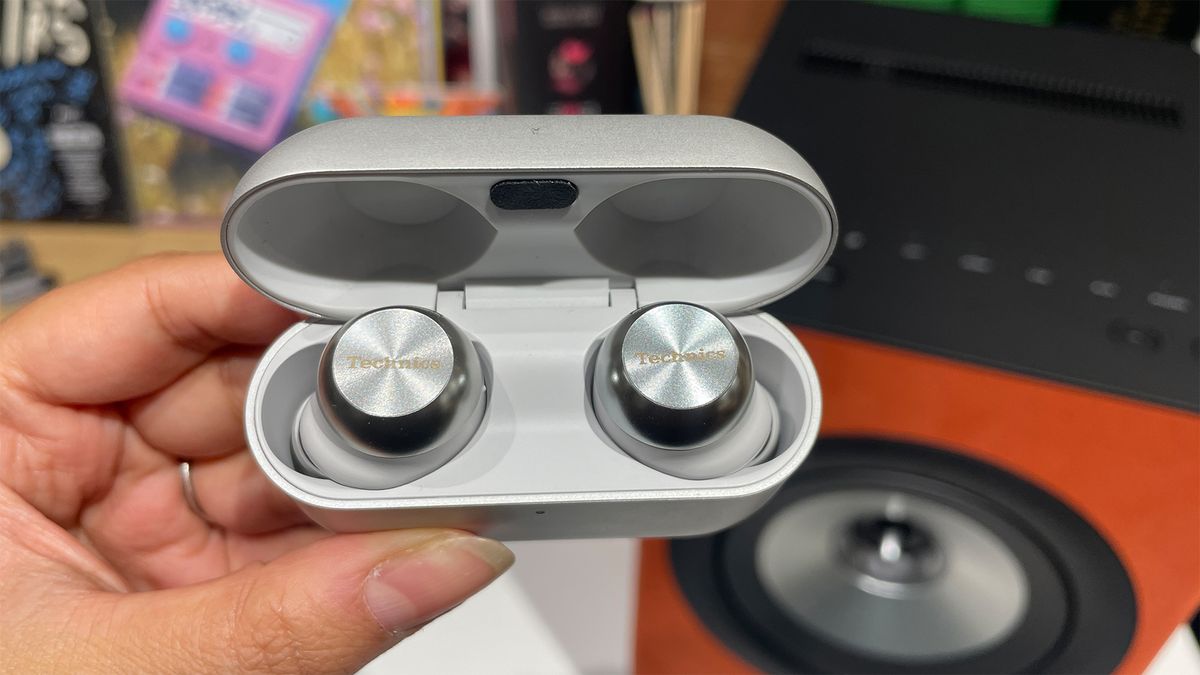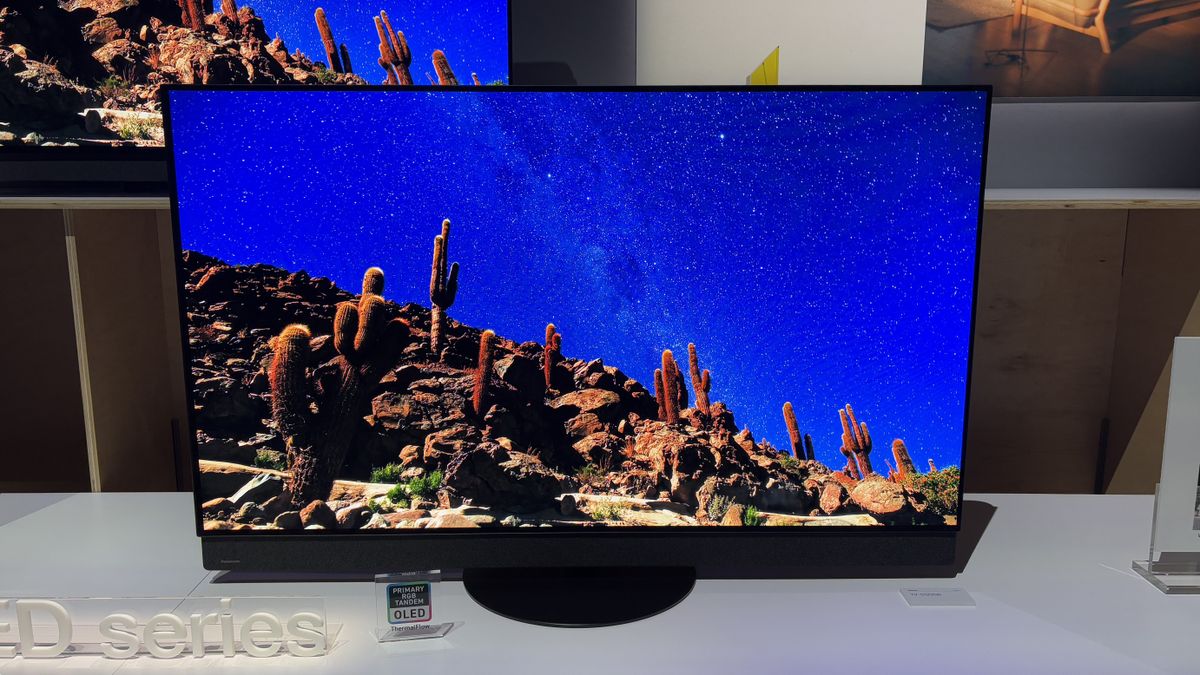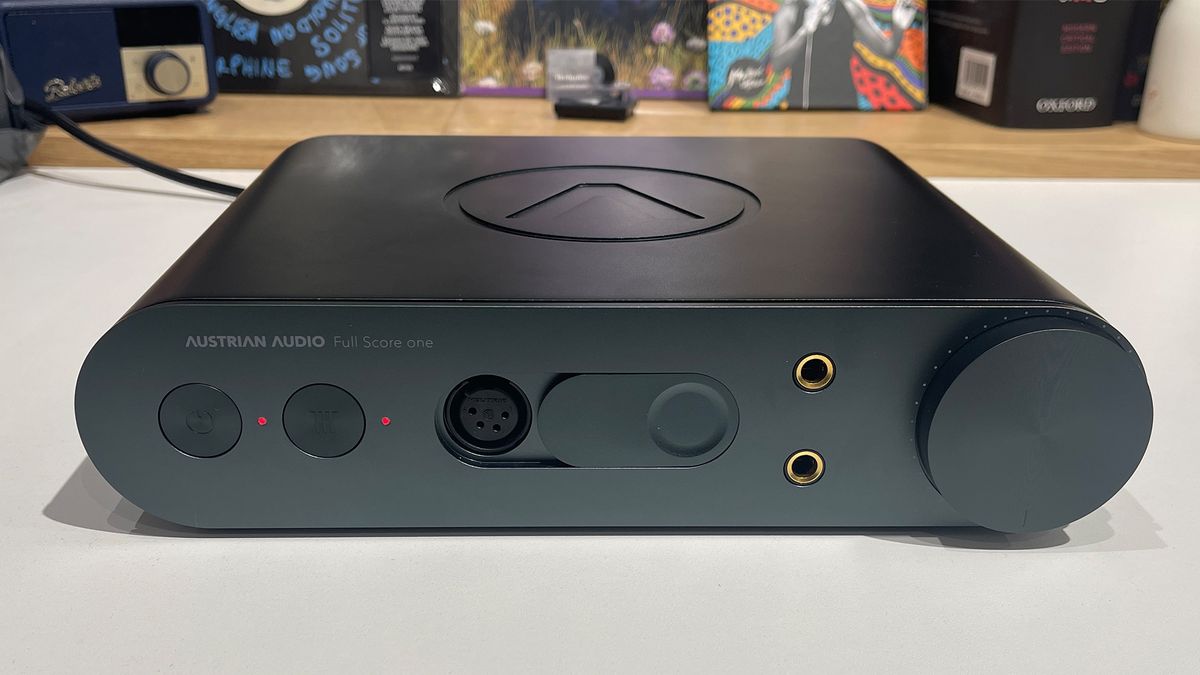Technics has started its 60th year with a bang. While the Japanese brand may be best known for its direct drive turntables and hi-fi electronics, it has decided to start off its diamond anniversary with a new flagship pair of wireless earbuds: the EAH-AZ100.
The AZ100 sit above the previous flagships, the EAH-AZ80, and are peppered with updates throughout, from a new driver and improved noise-cancelling to longer battery life and a new design. Are these the buds that will finally break Technics’ four-star run and, even more importantly, break the Sony/Bose stranglehold?
price“>Price
The new Technics EAH-AZ100 are priced at £259 / $299 / AU$499, which are the exact same prices that the AZ80 launched at in 2023. The AZ80 have gone down in price in the last year, but we’re still surprised – in a good way – that Technics hasn’t priced the AZ100 any higher.
We wouldn’t have been surprised to see them break the £300 barrier, as Bose QuietComfort Ultra Earbuds (£300 / $299 / AU$450) and Bowers & Wilkins Pi8 (£349 / $399 / AU$599) have in the UK, but the AZ100’s pricing puts it on par with the Sony WF-1000XM5’s original launch price of £259 / $299 / AU$419.
At the time of writing, Sony’s XM5 and Bose’s QC Ultra Earbuds have come down substantially – Sony to £175 and Bose to £219 – but these remain two of our favourite wireless earbuds in this key price range, so Technics still has formidable competition in this hotly contested market.
Design & comfort

The most obvious change that Technics has made is to the EAH-AZ100’s design. They are smaller, lighter and overall more comfortable to wear over long hours. The earbuds’ body has a more rounded shape that sits even more snugly in our ears, and weighs 5.9g per bud compared with the AZ80’s 7g. That’s the same weight as the Sony XM5’s buds, but we think the weight of the AZ100 is better distributed along the earbud as they sit in your concha compared with the denser-feeling XM5.
We joke that we have reviewers with both small and large lugholes on our team, but this proves handy when testing wireless earbuds as the fit can vary from ear to ear. With the AZ100, both extremes of our review team found a good, secure fit right from the start, with the earbuds staying in place and feeling comfortable, with no fatigue, throughout our weeks of testing.
Technics EAH-AZ100 tech specs

Bluetooth 5.3
Codec support LDAC, SBC, AAC, LC3
Noise-cancelling? Yes
Battery Life Up to 10 hours (with ANC on); 28 hours (with charging case)
Finishes x2 (Black, Silver)
Weight 5.9g each (earbuds); 42g (charging case)
You get five pairs of ear tip sizes in the box and we found it was easy to get the right fit and seal with no issues. The older AZ80s came with seven pairs; however Technics has said that the AZ100’s smaller body negated the need for those two extra sets of S and XS tips, and that those with smaller ears will find the AZ100 easier to get along with, with the tips provided. We’re happy to confirm that this was the case during our testing, even with no ear tip fit test in the app.
The touch controls available on each bud are comprehensive and entirely customisable, so you can tailor the AZ100 to exactly how you want to use them. The Technics Audio Connect app lets you assign any function to either earbud, meaning you can play/pause, skip and rewind, switch between noise modes, control volume, answer/reject a call and summon a voice assistant in any combination and with however many taps that feel sensible to you. We really like this degree of personalisation (a theme that’s carried throughout the general operation and within the app of these Technics buds). The controls are easy to use, although they can be a touch too sensitive: we find the single tap can sometimes be mistaken for a double tap at times, which can be frustrating depending on how you’ve set up the controls.

The charging case has been given a similar nip and tuck, and remains a slim, pocketable case that’s easy to carry with you. There’s a smaller LED at the front to indicate charging levels, and you can charge the case using a USB-C cable or Qi-compatible wireless charger. If we had to take issue with anything about the overall design, it’s that we’d like a stronger magnet for the charging case lid and for the contacts when placing the buds in the case. Rivals such as the XM5 and B&W Pi8 offer a more secure snap, and we find it just a little weak in the AZ100. We’ve sometimes worried that the lid would easily open and the earbuds would tumble out in our bag (which has happened with the AZ80) or from our hands when handling them outdoors.
Features
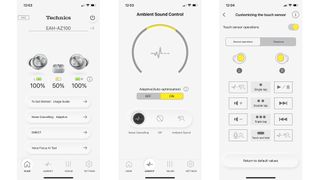
One thing we don’t have any issue with is the AZ100’s Bluetooth connection. It can be easy to take Bluetooth for granted and only mention it when there are issues with dropouts or instability, but the Bluetooth connection on the AZ100 stands out as being particularly strong. They connect without issue every time, stay stable in busy places like shopping centres and train stations, and never trip up when switching between multiple devices (smartphone, laptop, tablet) and back again.
Technics’ earbuds continue to support Sony’s LDAC codec that lets you stream music in higher quality from compatible sources, such as portable music players or select smartphones. New to the AZ100 is the inclusion of the LC3 codec that supports LE (Low Energy) Audio and Auracast transmissions.
Also returning is Technics’ three-way Bluetooth multipoint, which remains an industry first and works great in practice. You can switch seamlessly between three connected devices (all other earbuds have a two device limit), but Technics now offers greater control to users with how this feature operates. You can, for instance, decide you don’t want the AZ100 buds to automatically switch to the device now playing music or getting a call, or even limit the amount of sources connected. Technics says this change was made in response to customer feedback. Helpfully, the Connect app has clear explanations on each option, making it easy to choose what works best for you.
Another big feature that has been improved in the AZ100 is battery life. With active noise cancelling (ANC) turned on, you get up to 10 hours on a single charge and up to 28 hours with the case – that’s quite a jump up from the AZ80’s seven and 25 hours respectively. We’ve found the battery life to be robust; it certainly surpasses the six hours (single charge) and 24 hours (total) offered by Sony XM5 and Bose QC Ultra Earbuds. Technics also warns that the battery life reduces if you’re listening primarily using the LDAC codec (up to seven and 18 hours), so keep that in mind, hi-res fans.
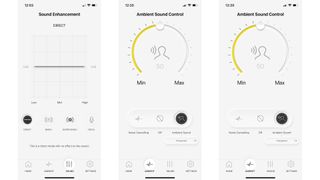
Other useful features that we would expect from a premium, flagship pair of earbuds are present and correct, such as wear detect (which pauses music when the earbuds are taken out of ears) and support for Dolby Atmos spatial audio and dynamic head tracking (which works well enough). There is a conversation mode, although the AZ100 doesn’t have speech-detecting features as found in the Sony XM5 and Apple AirPods Pro 2. You can set up a one-tap mode to enable the voice-focused ‘Attention’ ambient mode – this isn’t quite as natural as its rivals (more on this in the ANC section below), so we opt to keep this turned off.
Delve into the app’s settings and you’ll find further options, such as prioritising sound quality or connection stability to customising the app home screen. It’s not quite as granular as the seemingly millions of options found in the JBL Tour Pro 3/Live Beam 3’s app, but it’s a sensible amount that feels generous and useful.
ANC & call quality

Technics has made leaps when it comes to active noise-cancelling (ANC), too. Particular attention has been given to reducing noises in the low and mid frequencies – such as train rumbles, human voices, even footsteps – thanks to improved and repositioned mics. And the AZ100 are impressively effective noise-blockers. You can dial the intensity of ANC up or down, but when on full blast, it damps down noise around you like heavy snowfall muffling the world. It does a terrific job of muting those low-level engine rumbles, the humming of air conditioning and general traffic, or the chatter surrounding you to mere whispers. We like that there isn’t much of that ‘vacuum-like’ feeling you get with other ANC earbuds, either, making it more comfortable to listen with ANC turned on. Is it better than Bose QC Ultra Earbuds’ ANC quality? The Technics comes very close; the Bose is better at silencing those noises at the mid frequencies, such as the sound of typing on keyboards – but we find the AZ100’s ANC abilities very satisfying.
Whereas previously you only had full ANC and Ambient modes to choose from, the EAH-AZ100 now offers an Adaptive option, which automatically adjusts to offer the best noise-cancelling level for your fit and environment. It works well enough that we opt to keep this Adaptive mode turned on instead of full ANC, and it does a decent job of adapting to changing noises during our daily commute.
There’s scope to customise the amount of ANC and Ambient noise (out of 100) you want to deploy, while there are two further options in Ambient mode. ‘Transparent’ mode lets all noise in as standard, while the ‘Attention’ mode amplifies voices specifically. We’re not too fond of this latter mode as it tends to enhance the higher frequencies of voices but in a rather unnatural, over-processed way that just doesn’t sound natural. Switching to the normal ‘Transparent’ mode lets the deeper notes of voices come through and sounds more natural, even with more general noise coming through alongside.
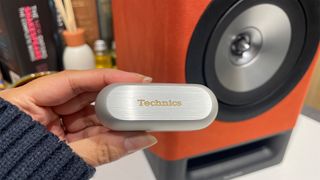
There are three mics in each earbud for noise-cancelling and call quality. Technics has swapped out the JustMyVoice technology in the AZ80 for a new ‘Voice Focus AI’ noise reduction tech for clearer call quality for yourself and the person on the other side (again, also customisable in the app). With the use of a new AI-equipped chip, this eliminates surrounding environmental noises when on calls, so that the focus is solely on your voice. This works very well when taking a call in windy or noisy outdoor areas, and we found the sound of wind completely eliminated during our tests. However, this does leave our voices feeling rather unnatural with a hard edge, with the recipient on the other end even calling it ‘robotic’ at times. With the Voice Focus AI turned off, voices are more muffled from surrounding noise, but we do sound more natural overall. For day to day video and phone calls in quieter indoor spaces, however, the AZ100’s call quality is perfectly fine, sounding on a par with the Sony XM5, with our voices coming through clearly and with enough expression.
Sound

Once we start listening to the AZ100, it doesn’t take long to discern where their strengths lie. We’re immediately met with a wonderfully clear and open sound, with a superb amount of detail. The plucking of strings in Agnes Obel’s The Curse is clearly defined and packed with tactility, while the layers of nuance in her strong but delicate voice are revealed effortlessly.
The AZ100 have a livelier and more nimble presentation than the AZ80, along with more solidity and confidence underpinning each note. There’s a better sense of dynamic subtlety and punch behind the flutes and strings in the Jurassic Park theme; they sound more expressive, with clear intention behind each musical instrument being played. Flutes and piano notes sound sweet but full of detail, while there’s a great sense of the space in which a song, especially from a live orchestra, is being played. It’s an impressively spacious and open presentation, even more so than the Sony XM5.
We really like the overall even-handed balance of the EAH-AZ100. This is something we’ve praised in previous Technics earbuds, and it’s even more impressive in the AZ100. The highs are clear and have ample space to soar, while the bass performance lands with much more impact than before. They never sound overly meaty or heavy though; the opening bassline in Massive Attack’s Angel has heft but it is also pulled taut with enough grip and agility to drive the brooding track.
How has Technics improved the sound from the previous generation? The AZ100 uses a 10mm “Magnetic Fluid Driver” that delivers clearer sound and improvements across the frequencies. Technics has used this magnetic fluid driver technology before in the premium EAH-TZ700 in-ear wired headphones (tested at £1100), and the engineers’ aim was to implement this technology successfully in the smaller drivers of a wireless earbud. It features an oil-like substance with magnetic properties that improves power handling and helps to damp any unwanted rocking motion of the diaphragm (without adding mass). The resultant improvement in stability allows for a thinner surround, resulting in greater low-end power. Meanwhile, the stiffness of the aluminium diaphragm delivers smoother mids and high frequencies, all while keeping distortion levels low.

Altogether, this results in the clearer, more precise and more impactful sound we hear in the AZ100, while still keeping things balanced and even. The AZ100 are fairly transparent too; we play Fleetwood Mac’s The Chain in 24-bit/96kHz FLAC quality from the Astell & Kern SR35 using the LDAC codec, and we immediately get an uptick in muscularity, detail, solidity and even more space between instruments. The background of Obel’s The Curse is even quieter and allows for more detail to be revealed, while the soundstage is deeper and wider. Playing songs over Tidal and Apple Music using an iPhone 12 doesn’t lessen our enjoyment, however, and we find ourselves enjoying the AZ100’s performance regardless of source or file quality.
We find the AZ100 more detailed and clearer than the Sony XM5, but the Sony’s fuller, richer sound – especially in the bass – will appeal to those whose music collection relies on rhythmic drive and propulsive timing. The Technics gets pretty close though, although we wouldn’t say no to greater momentum and more attitude for certain songs that demand it. Through the Sony XM5, you get a better sense of the menacing mood in Ice T’s Addicted To Danger and the playful, flirty nature of Coi Leray’s Players.
There’s scope to tweak the AZ100’s sound with EQ settings, from presets or you can even create your own. The Bass+ mode does add a little more punch and snap at the lower end when you need it, but it does so at the expense of that lovely even balance. We prefer to leave the AZ100 on Direct (no EQ) mode for most of our listening. The earbuds have also been tuned so that there’s a small bump in the bass when ANC is turned on to sound more lively and exciting, which many of us were happy with, although you’ll want to keep ANC turned off if you prefer the buds’ innate natural, clearer balance. Spatial audio performance is decent, and the dynamic head tracking effect when listening to Dolby Atmos tracks is surprisingly subtle. We find it takes away some of the clarity and space we like so much from the AZ100’s natural sound, though.
Verdict

Technics has finally done it, gaining that fifth star that has so far eluded them. The AZ100 is a well-thought-out design, with a comfortable fit, useful features and scope for customisation at nearly every step. But it’s the elevated performance that combines the Technics’ strengths of clarity, detail and spaciousness with the punch, presence and dynamic impact we were hoping for that cinches the deal.
With a Bose-bothering ANC performance and a Sony-bothering sound performance, the Technics EAH-AZ100 has emerged as a true contender in the ultra-competitive wireless earbuds field.
First reviewed: January 2025
SCORES
- Sound 5
- Comfort 5
- Features 5
MORE:
Read our review of the Sony WF-1000XM5
Also consider the Bose QuietComfort Ultra Earbuds
Technics EAH-AZ100 vs Sony WF-1000XM5: which premium wireless earbuds are better?
Best wireless earbuds: top pairs tested by our reviewers







